Understanding LEL – Lower Explosive Limit
The Lower Explosive Limit (LEL) is a crucial safety parameter that defines the lowest concentration of a gas or vapour in air that can ignite when exposed to an ignition source. Expressed as a percentage by volume, knowing the LEL helps prevent fires and explosions in industries dealing with combustible gases.
Importance of LEL in Safety
Monitoring LEL is essential for maintaining a safe work environment. Gas detection systems often display gas concentrations as a percentage of LEL, allowing workers to take action before reaching dangerous levels. For example, if methane has an LEL of 5%, an alarm may trigger at 1% (20% LEL).
Calculating LEL
To calculate the LEL percentage, divide the gas concentration by its LEL value. For instance, a 2% methane concentration would be calculated as (2% ÷ 5%) x 100 = 40% LEL.
Comparison Chart of Common Gases
Here’s a comparison chart of LEL values for some common gases:
| Gas | LEL (% by volume) | UEL (% by volume) |
| Methane | 5.0 | 15.0 |
| Propane | 2.1 | 9.5 |
| Hydrogen | 4.0 | 75.0 |
| Carbon Monoxide | 12.5 | 74.0 |
| Acetylene | 2.5 | 100 |
This chart provides a quick reference for the Lower Explosive Limit (LEL) and Upper Explosive Limit (UEL) of common gases. It’s important to note that these values can vary slightly depending on environmental conditions and the source of information.
Conclusion
Understanding LEL – Lower Explosive Limit is vital for workplace safety in environments with flammable gases. The comparison chart highlights the variability of LEL among different gases, emphasizing the need for specific gas detection and safety measures. By integrating LEL data with other safety measures and referring to accurate LEL values, organizations can effectively mitigate risks and protect their workforce from potential hazards.





